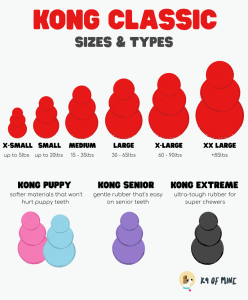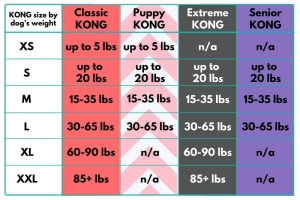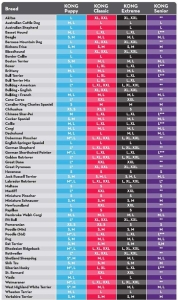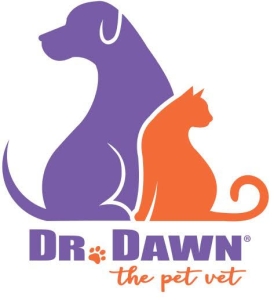
Kong toys have been on the market for decades. There is a vast array of options, from thick rubber stuffable chew treats to balls and pull toys, all thick and helpful for teething.
Specifically, the appropriately sized Kong chewable rubber toy that can be stuffed with food is a great way to entertain bored dogs, help them teeth in a non-destructive way, and is a supplement to training and playing with dogs that I have been recommending to clients for decades.
Here I discuss those Kong products and go into more detail about why I like them.
Benefits:
As a veterinarian and long-time Labrador pet parent, I depended on Kongs to entertain my dogs, who loved to chew and get into trouble when I was not around. They are mentally and physically stimulating, and offer teething pups an acceptable reason to chew. I love that they learn to entertain themselves. It is especially helpful to dogs who have generalized or separation anxiety, distracting them for 20 minutes to an hour. Kongs can be filled with their regular food, helping slow down their meal time. While not a substitute for brushing teeth, it can help prevent periodontal disease. I also recommend smearing dog appropriate toothpaste on the outside for this purpose.
Safety tips:
I recommend you assess your dog’s degree of chewing, and use with supervision initially. If your dog has a very powerful jaw and breaks down pieces, even of the thickest black version, then it is not right for your dog. Pieces can break off, be swallowed and potentially cause obstructions, necessitating surgical removal. But for most others, it has earned the endorsement of veterinary dentists, because it is not considered too hard for dog teeth, that can become cracked with certain very hard treats and bones. Consider the Knee-Cap rule: If you would not want to be hit in the kneecap with something, it is too hard for your dog to chew on.
Also, there have been reports of dogs getting their tongue stuck in the Kong due to suction and a vacuum effect, while avidly licking to reach stuffed treats. The second, small hole at the end is designed to avoid this. To avoid it, push a straw through the Kong, in one hole and out the other, before freezing it. Remove the straw when ready to give the Kong to your dog.
They come in several sizes and degrees of firmness. I generally recommend to select the largest size your dog’s jaw will tolerate, or even erring on the next larger size up than that listed on their chart. They are available as light blue and pink ones which are softer, smaller ones for puppies, red ones for the average chewer, black for the toughest rubber and power chewers, and softer purple ones for older dogs.

The following charts help you choose the appropriate size and type for your dog. Age and weight play a big role in the selection.

They also have a breed guide chart:

Recipes:
Most dogs will get bored with any toy, so rotating types of toys is helpful. Kongs are great because you can fill them with treats and kibble, which makes them appealing to dogs of all ages. The company sells several inserts in flavors such as peanut butter, bacon and cheese, and liver. I prefer to fill them with my dog’s own softened kibble, canned food, and other foods. If you plug up the large hole on the end with a soft cheese or peanut butter, there are a multitude of stuffing options. My favorites: softened sweet potatoes, green beans, berries, baby food, scrambled eggs, sardines, ground meat (chicken, beef, etc.)
A favorite (sweet) recipe my dogs adore: I combine cream cheese with blueberries, stuffing the toy and sealing with cream cheese or peanut butter. Your pet may prefer cottage cheese and strawberries, or mashed bananas, mixed with the berries. I personally find the thickness of cream cheese makes a better “plug” than cottage cheese. Try variations.
Another favorite (savory) recipe: Scrambled eggs (1 part), combined with 2 parts softened kibble or canned food, and some cheese sprinkled for taste, melted in the microwave and stuffed into the Kong. You may also melt it, once stuffed, in the microwave, then cooled before giving to the dog. I prefer to add the food to the Kong after heating, to extend the life of the rubber.
The most useful way I have found to use a Kong is to entertain a dog working hard and long at eating a frozen stuffed Kong. All of the above options and recipes work frozen, for 20 minutes or more before serving.
Rinse with warm water and dish soap. If you have dried or stuck food, soak the Kong first. Baby bottle brushes or old toothbrushes work well to access all the nooks and crannies.
Clean after each use, rinse well. Avoid boiling, which can wear down the rubber quicker. You can put them in the dishwasher on the top rack, but again, the high heat may accelerate the breakdown of the rubber.
Discard if the Kong starts to break down, seems sticky, or has oil leech out, or if it cracks and separates or pieces are missing. If well cared for, a regularly used Kong may last for 7-8 years.
Dr. Dawn




